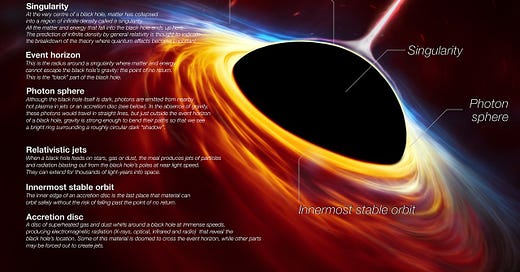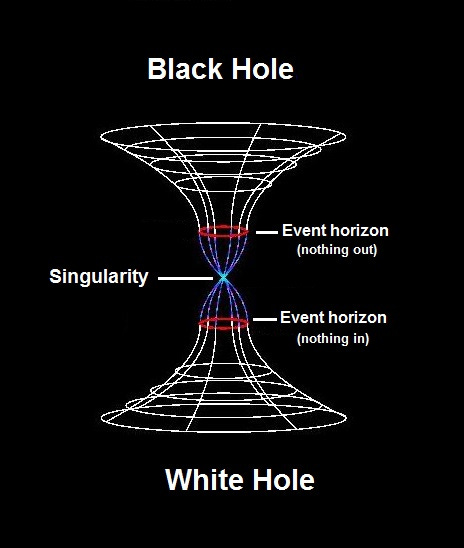Abandon all hope, ye who enter here. - Dante Alighieri
Greetings, fellow scientist
Astronomers and space enthusiasts talk about Black holes a lot because we just cannot seem to get enough of them. We give them a great deal of attention. But today let’s just talk about their bizarre twins - White Holes.
The equations of general relativity theorized the existence of white holes as it does for its collapsed star counterpart, black holes. Some physicists even claim that these twins swirling astronomical objects in spacetime can be the two sides of the same coin.
In 2019, black holes were finally proven to be REAL. Does that suggest that white holes are an undeniable occurrence of the universe, too? What is a white hole? How do they form? How do they work? And, do they even exist at all? Can a white hole turn into a black hole? Is a white hole, a black hole’s time reversal?
There are many more questions than answers regarding white holes, which leaves room for plenty of imaginative theories about a white hole.

How Black and White Holes Differ?
From afar, a white hole would appear identical to its better-known cousin, a black hole. Likewise, a white hole could be huge or small, might spin or remain static, and could be electrically charged. A white hole would also be enclosed by a ring of dust, and a cloud of gas and debris would accumulate at its event horizon.
The key difference between a black hole and a white hole is that a white hole burps. Yes, this neglected twin can burp matter outside!

Contrary to a black hole that nothing can escape, matter can traverse the event horizon and get out of a white hole. It’s only in these moments, when objects emerge from the white hole, that scientists can definitively say that what they are looking at is a white hole and not a black hole.
If a black hole’s event horizon is the point of no return, then the event horizon of a white hole could be described as the point of no admission as nothing can ever surpass the event horizon of a white hole and reach the center.
In a black hole, matter in the space outside can travel the event horizon to fall in the interior of the black hole, but objects within the black hole can never again interact with space outside. In a white hole, the reverse holds. Objects from inside the white hole can cross the event horizon and interact with objects in the space outside of it, but nothing on the outside can ever enter the white hole or affect the inside.
How do White Holes May Form?
While Einstein’s theory of general relativity describes both black and white holes, it doesn’t explain how a white hole might form in space. A black hole forms when a dying star implodes in a supernova, collapsing all of the star’s matter into an impossibly tiny area isolated from the rest of space.
The reverse doesn’t quite make sense. The idea of a white hole exploding into a fully functioning star would be a bit like unscrambling an egg which violates the statistical law that entropy must increase with time.
Hal Haggard1, a theoretical physicist at Bard College in New York, says
If a white hole did form, the matter it releases when it “burps” would collide with the matter in orbit around the white hole. These collisions would cause the entire system to collapse into a black hole. Conceivably if white holes do exist, they don’t remain as a white hole for long. Hence a long-lived white hole is very unlikely.
Accordingly, this legendary space occurrence will probably transform into another mysterious opponent, the black hole, even before its discovery by the Earthlings.
Other scientists have different theories about white holes that help explain some of the inconsistencies.
Other Possible Interpretations
Steven Hawking discovered back in the 1970s that black holes leak energy, which led him to wonder how black holes die? And what happens to everything trapped inside a black hole when it dies? He theorized that quantum mechanics prevents any information inside a black hole from being deleted. So where does it go?
Some have taken this to mean that a white hole is the result of the death of a black hole. As a black hole dies, it may become so small that it would no longer obey the laws of physics as we know them. This resulting infinitesimally tiny object would disobey gravity.
However, inside it would hide a cavernous interior full of everything it swallowed in its previous life as a black hole. Its small size and gravity-defying behavior could allow it to remain stable enough to eventually spit out information and matter that had been swallowed by the black hole, thus, becoming a “burping” white hole instead.
Thus, as scientists suspect, after millions of years, black holes will become white holes. All the energy and matter they have consumed over the years will be ejected back to space.
We may still be a long way off from being able to look into a telescope and watch with our own eyes a white hole burping out matter into the surrounding universe. But one thing the past has definitely taught us is that just because we cannot see something does not mean it isn’t out there. Only time will tell which theory about white holes will prove to be correct or if we had it completely wrong all along.
Being a space enthusiast I am certain that one day we will get an answer to the question “What is a white hole?” But till then, it continues to remain yet another of the countless mysteries of our immense and unknowable universe. Moreover, a great astronomer Carl Sagan once said-
Imagination will often carry us to worlds that never were, but without it, we go nowhere.




